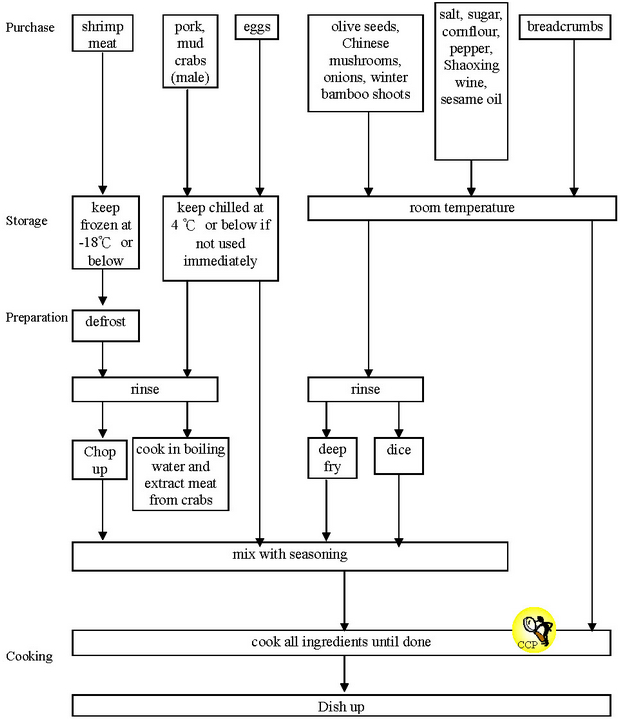
Published by the Centre for Food Safety
Contents
Feature Article
"Live it, Use it" Nutrition Labelling Promotion Award Scheme and "Live it, Use it" Nutrition Labelling Fun Shopping Award Scheme
Readers' Corner
(I) Allergens in Prepackaged Food
(II) Radiological Standard for Bottled/Packaged Waters under Routine Condition
Food Safety Q&A
(I) Why shouldn't we consume mushrooms casually picked?
(II) What particular attention should be paid if members of the public harvest clams or shellfish from sandy shore?
News on New Dishes
Fried Breaded Crab Shells with Crab Meat
Food Safety Plan Corner
Fried Breaded Crab Shells with Crab Meat – Cook Food Thoroughly
Briefing of Activities
(I) Roving Exhibition on Food Safety
(II) "Safe Food • Gourmet Paradise" Photo Competition
Truth against Fallacy
Can we ensure safe food handling by using gloves?
Brain Gym
Enquiry and Subscription
Feature Articles
"Live it, Use it" Nutrition Labelling Promotion Award Scheme and "Live it, Use it" Nutrition Labelling Fun Shopping Award Scheme
Since coming into force, the Nutrition Labelling Scheme has helped the public understand the nutritional content of food and indirectly encouraged the food trade to produce food items that meet the nutritional standards. Nutrition labelling is becoming part and parcel of our eating experience for developing healthy eating habits.
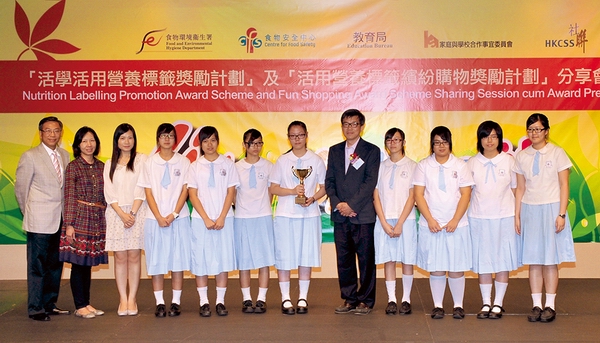
[Picture above: Mr SIN Tak-wah, Chief Curriculum Development Officer (Technology Education), the Curriculum Development Institute, Education Bureau, presents the Gold Prize to the award-winning school, Christian Alliance S W Chan Memorial College.]
Our younger generation is the primary target group of the nutrition labelling promotion programme. Topics on nutrition information and nutrition labelling have been integrated into the school curriculum. In order to further support and promote education on nutrition labelling, the "Live It, Use It" Nutrition Labelling Promotion Award Scheme (the Promotion Award Scheme) has been launched since the 2010-11 school year. The Promotion Award Scheme is jointly organised by the Centre for Food Safety (CFS) and the Education Bureau, and supported by the Committee on Home-School Co-operation. It aims at encouraging students to actively participate in nutrition labelling promotional activities for developing healthy eating habits through the wider use of nutrition labels. This year, a total of 28 teams from 18 secondary schools took part in the Promotion Award Scheme. They organised various creative activities to promote nutrition labelling in their schools. Some of them even reached out to the community to promote the message.
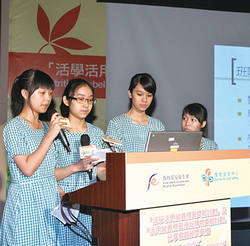
Apart from focusing on the younger generation, we also look towards participation of community organisations. This year, a brand new "Live it, Use it" Nutrition Labelling Fun Shopping Award Scheme (the Fun Shopping Award Scheme), supported by the Hong Kong Council of Social Service, was launched. A total of 18 community service organisations took part in the Fun Shopping Award Scheme. The objectives of the Fun Shopping Award Scheme are two-fold: to encourage staff members, group leaders and volunteers of community service organisations to organise promotional activities on the use of nutrition labels; and to encourage the public to use nutrition labels and record the use of nutrition labels in their daily food choices by completing the "My Shopping Diary" provided by the CFS through engaging in the promotional activities of the community service organisations.
[Picture on the right: Students are sharing their experience and the things they have learned from taking part in the promotional activities.]
Sharing Session cum Award Presentation Ceremony
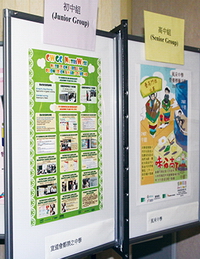
[Picture on the left: An exhibition of contest items.]
In recognition of the enthusiasm and dedication of all the participants and to offer them an opportunity for exchanging their experience, a Sharing Session cum Award Presentation Ceremony of "Live it, Use it" Nutrition Labelling Promotion Award Scheme and Fun Shopping Award Scheme was held on 9 July 2012 at Tsuen Wan Town Hall. During the event, the posters designed by school teams and the shopping diaries prepared by the individual award winners were exhibited. Some participants gave presentations of the details and purpose of their activities during the Sharing Session.
The Award Presentation Ceremony kicked off at 3:00 p.m. and was officiated by Mr Clement LEUNG, Director of Food and Environmental Hygiene. Prize presenters at the ceremony included Dr Gloria TAM, Controller of the Centre for Food Safety, Mr SIN Tak-wah, Chief Curriculum Development Officer (Technology Education), the Curriculum Development Institute, Education Bureau, and Mr Christopher YU, Member of the Working Group on Information, Committee on Home-School Co-operation. Other officiating guests included Professor KWAN Hoi-shan, Chairman of the Expert Committee on Food Safety, Ms Elaine LAM, Service Head, Rehabilitation Service, Caritas Social Work Services Division, Ms POON Suk-mei, Curriculum Development Officer (Technology Education), the Curriculum Development Institute, Education Bureau, Ms Vera KEUNG, Health Promotion Officer, I.C., Centre for Health Education and Health Promotion, The Chinese University of Hong Kong, Ms Janet LOK, Cluster Coordinator (Diet), Hospital Authority New Territories East Cluster, Mr Gordon CHEUNG, President-elect, Hong Kong Nutrition Association, Mr Peter JOHNSTON, Representative of Hong Kong Retail Management Association, Dr SO Man-chit, Amen, Central Health Unit, Department of Health and Ms Evida CHENG, Dietitian, Elderly Health Service, Department of Health. A video produced by the CFS highlighting the activities of both schemes and feedbacks of the participants was broadcast during the ceremony. Congratulations are hereby extended to all winners! They are expected to keep using nutrition labels in their everyday life and continue promoting nutrition labelling.
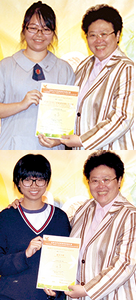
[Picture on the right: Dr Gloria TAM, Controller of the Centre for Food Safety, presents prizes to the winners as encouragement.]
[Picture below: Mr Clement LEUNG, Director of Food and Environmental Hygiene, presents prizes to the winners of the "Live it, Use it" Nutrition Labelling Fun Shopping Award Scheme.]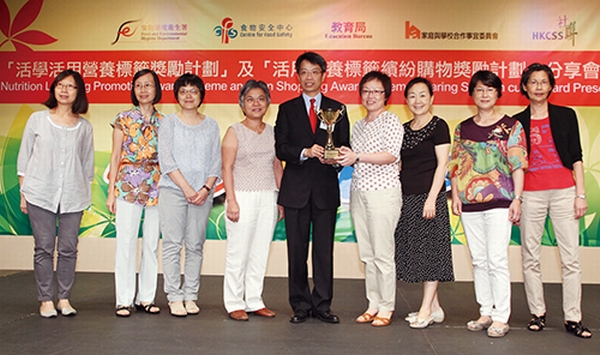
"Live it, Use it" Nutrition Labelling Promotion Award Scheme - List of Awardees
Senior group:
Gold prize: Christian Alliance SW Chan Memorial College
Silver prize: Elegantia College
Bronze prize: Kowloon True Light Middle School
Merit prize: The Y.W.C.A. Hioe Tjo Yoeng College
Junior group:
Gold prize: The Y.W.C.A. Hioe Tjo Yoeng College
Silver prize: Ning Po No. 2 College
Bronze prize: TWGHs Sun Hoi Directors' College
Merit prize: Christian Alliance Cheng Wing Gee College
"Live it, Use it" Nutrition Labelling Fun Shopping Award Scheme - List of Awardees
Organisation participant:
Gold prize: Caritas Community Centre - Caine Road
Silver prize: Hong Kong Juvenile Care Centre - Bradbury Hostel
Bronze prize: Caritas Integrated Family Service Centre – Aberdeen
Merit prize: Hong Kong Young Women's Christian Association Jockey Club Tin Shui Wai Family Wellness Centre
Individual participant:
Outstanding awards: Ms CHAU Yuk-ching and Ms KAN Sau-king
Special recognitions: Ms KONG Wai-fun and Ms LAU Mei-yi
[Picture below: Group photo of awardees and guests.]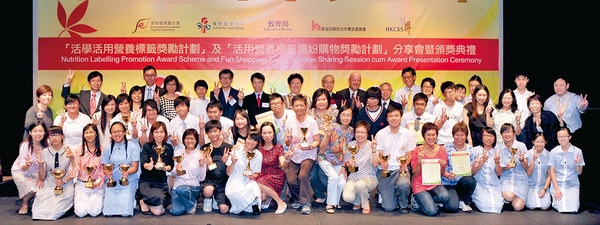
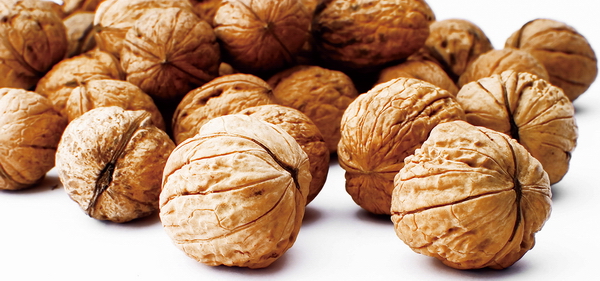
Readers' Corner
Allergens in Prepackaged Food
Food allergens are food that can cause food allergies. In Hong Kong, manufacturers of prepackaged food are required to indicate on the food label the presence of the eight specified allergens (sulphite; cereals containing gluten; crustacea; eggs; fish; milk; tree nuts; peanuts, soyabeans and their products) under the Food and Drugs (Composition and Labelling) Regulations.
Food allergies may cause an immunologic response in sensitive individuals. Adverse reactions to food allergens are seen in people who suffer from food allergies while most people are not affected, even though the exposure to the allergens is very small. For example, people who are allergic to milk protein may develop symptoms like vomiting, diarrhoea and rash upon consumption of food containing milk protein and in severe cases anaphylactic shock.
Common allergic reactions such as vomiting, abdominal pain, asthma, rhinitis, angioedema and urticaria do inflict sufferings to allergic persons. In some serious cases, anaphylaxis, which is a severe systemic allergic reaction, can occur minutes after contacting an allergen. Immediate medical attention is necessary in these cases to prevent serious consequences.
Starting from April 2012, results of compliance tests for allergens as well as details of prepackaged food samples with undeclared food allergens have been published on the CFS website on monthly basis. Individuals with food allergies are advised to take note of food alerts issued on the CFS website and to subscribe to E-news to receive e-mail notifications.
Food Safety Tips for Ready-to-Eat Food
When supplying ready-to-eat food, we should observe the 5 Keys to Food Safety. They are:
Choose, Clean, Separate, Cook and Safe Temperature
Buy food from approved and reliable sources. When choosing food, pay attention to their quality. On receipt of food, check their quality and store them properly at a suitable temperature. When supplying food, make ensure that no foreign substances are present.
Radiological Standard for Bottled/Packaged Waters under Routine Condition
Ever since the quake-led nuclear incident in Japan, the CFS has been adopting the guideline levels laid down in the "General Standard for Contaminants and Toxins in Food and Feed (CODEX STAN 193-1995, amended 2010)" (GSCTFF) of the Codex Alimentarius Commission (Codex) for testing radionuclide levels in foods. The Codex guideline levels serve as an international standard following a radiological or nuclear emergency to safeguard public health and facilitate international trade.
Well over a year after the incident, the CFS considered it an appropriate time to adopt the radiological standard set out in Codex "General Standard for Bottled/Packaged Drinking Waters (Other Than Natural Mineral Waters) (CODEX STAN 227-2001)" for bottled/packaged waters under routine condition, after taking into account current international standards, risk assessment and other relevant factors. This standard states that no bottled/packaged drinking waters shall contain substances or emit radioactivity in quantities that may be injurious to health and the drinking waters shall comply with the health-related requirements of the most recent "Guidelines for Drinking-water Quality" (GDWQ) published by the World Health Organization (WHO). According to the 2011 edition of the GDWQ, the guideline level is 10 becquerel per litre (Bq/L) for Iodine-131, Caesium-134 and Caesium-137 respectively. The sum of the radiation level should not exceed 10 Bq/L if multiple radionuclides are detected in one sample.
While the Water Supplies Department has also been following WHO's GDWQ as the standards for the quality of drinking water in Hong Kong, the Expert Committee on Food Safety (Expert Committee) supported the CFS's adoption of this standard for bottled/packaged water under routine condition. The new radiological standard, which took effect on 1 August 2012, is applicable to bottled/packaged waters imported from Japan and all other countries.
As for food commodities other than bottled/packaged waters, the Expert Committee noted that there are no relevant standards on radionuclide levels under normal conditions and recommended that the guideline levels stipulated in the GSCTFF should continue to be in force. Since these Codex guideline levels are widely acceptable for international trade and provide sufficient protection for public health, the CFS will keep adopting the GSCTFF guideline levels for other food commodities.
A Handy Tip to Get the Temperature Right
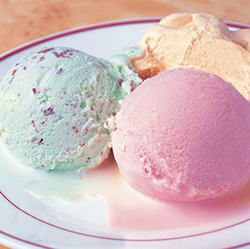
Always keep frozen food items at -18℃ or below and chilled items at 4℃ or below.
Food Safety Q&A
| Q: | Why shouldn't we consume mushrooms casually picked? |
|---|---|
| A: |
Low in fat and rich in protein, amino acids as well as vitamins, mushrooms are healthy choices of food. Either sautéed or cooked in hotpots, mushrooms are delicious and are Hong Kong people's favourites. However, there have occasionally been cases of food poisoning related to consumption of mushrooms by members of the public. Food poisoning related to consumption of mushrooms are generally caused by:
|
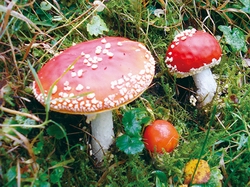
Mushroom toxins are naturally formed by fungi. Most mushroom toxins that cause human poisoning cannot be eliminated by cooking, canning, freezing or other means of food processing. Mushroom poisonings are generally acute and the incubation period is relatively short. The severity varies and depends on the species and amount of the mushrooms consumed. Nausea, vomiting and abdominal pain are the most common symptoms. Extreme thirst, profuse sweating, hallucination, coma and other neurological symptoms may sometimes occur.
At present, there are no simple methods to identify all poisonous mushrooms. There are many folk traditions on identifying poisonous mushrooms: that they are usually brightly coloured, insect free or with volva; or they turn the silverware black. Nevertheless, these folk traditions are unreliable. Among the over 380 known species of mushrooms in Hong Kong, about 10 percent are poisonous. Since it is difficult to distinguish between edible and inedible mushrooms, the public is advised not to collect and consume wild mushrooms. If suspected poisonous mushrooms are accidentally consumed, the patient, together with the samples of the poisonous mushrooms consumed, should be sent to the hospital for consultation immediately.
| Q: | What particular attention should be paid if members of the public harvest clams or shellfish from sandy shore? | |
|---|---|---|
| A: |
Never consume shellfish harvested from contaminated waters. Discard any shellfish with incomplete shell or abnormal smell. Well pack and store raw shellfish on the bottom shelf of refrigerators at or below 4℃ to prevent their juices from contaminating cooked food and ready-to-eat food which should otherwise be placed on upper shelves. When preparing shellfish, scrub and rinse their shells, remove their intestines and cook thoroughly before consumption. Heat them to an internal temperature of 90℃ for 90 seconds, or boil them at 100℃ until their shells open and boil for additional three to five minutes afterwards. Discard any cooking liquid before consumption. |
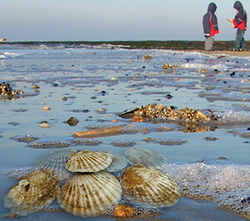 |
News on New Dishes
Fried Breaded Crab Shells with Crab Meat
The Express has interviewed Fung Shing Restaurant, a signatory of the Food Safety Charter. Being a time-honoured restaurant in the trade, Fung Shing meticulously produces superb cuisine widely acclaimed by diners. One of the delicious dishes is Fried Breaded Crab Shells with Crab Meat. Let's take a look at the preparation of the dish, with demonstration by Chef TONG of the restaurant.
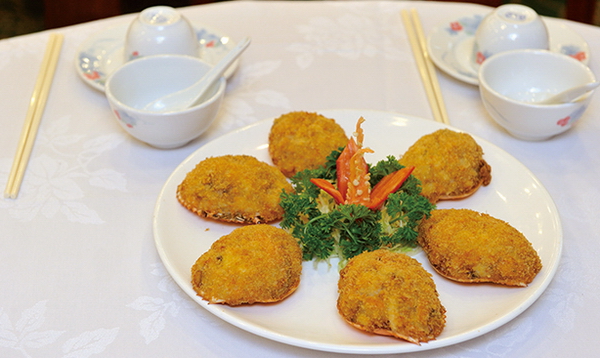
[Photo Caption: Fung Shing's Fried Breaded Crab Shells with Crab Meat is both aromatic and delicious.]
| Preparation Steps | Small Tips, Big Wisdom | |
|---|---|---|
Buying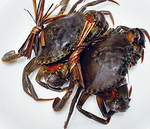 |
Purchase ingredients from reputable and licensed food suppliers. Buy fresh mud crabs (male) and shrimps. Upon receipt of the ingredients, check carefully to ensure their quality. Store fresh ingredients in the refrigerator. | Purchase ingredients from reliable suppliers and check them carefully upon receipt in order that the food bought is of good quality. Store food properly to make certain that the ingredients will not deteriorate. |
Cutting |
Separate crab shells from crabs and cut the crab bodies into pieces. Remove internal organs and legs of the crabs. Rinse the ingredients thoroughly. Chop up pork and shrimp meat for later use. Dice prepared Chinese mushrooms, onions and winter bamboo shoots for later use. | Remove internal organs of crabs and shrimps. Before cutting the ingredients, rinse them thoroughly and drain off any excessive water. Don't chop up pork and shrimp meat too finely as coarsely chopped meat can produce better chewy texture. |
Cooking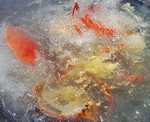 |
Cook crab shells and crab bodies in boiling water for 8 minutes. Then extract meat from crabs for later use. Stir fry onions until fragrant and set aside. | Olive oil is not only healthy but can bring out the flavour of food. However, one should choose the type suitable for high heat cooking. |
Stuffing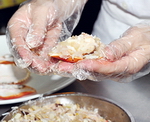 |
Mix the prepared ingredients, seasoning and a suitable amount of egg white together. First brush the inside of crab shells with a layer of egg white. Then stuff a suitable amount of filling into the crab shells. Glaze filling with beaten egg yolk and coat with breadcrumbs. | Lightly press the ingredients with hands to squeeze excessive water out so the ingredients do not sweat upon mixing. The adding of egg white sticks the ingredients together and enhances the chewy texture. Lightly press the filling with hands after stuffing so that the filling will not come off easily during the deep frying process. |
Deep frying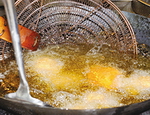 |
Deep fry the stuffed crab shells in boiling oil for about 4 minutes until the surface turns golden brown. | Make sure the filling is cooked thoroughly. Cooking time depends on the size of crab shells and the amount of filling. It takes about 4 minutes of deep frying for the filling of an average-sized crab shell to be thoroughly cooked. |
Tips from Chef TAM:
Fung Shing Restaurant purchases ingredients from reputable food suppliers to reduce any food safety risks. In doing so, the source is traceable in case there are problems with the food. When buying or receiving the ingredients, the staff will carefully check whether the food is fine and fresh as the selection of good ingredients can ensure food quality. Their cuisine is all made to order, which not only maintains the taste quality but also prevents the food from cross-contamination during storage.
As for personal hygiene, their kitchen staff, waiters and waitresses have attended hygiene training courses and developed good personal hygiene awareness. It is the practice of their kitchen staff to wear gloves during the preparation of food. The worktops must be washed before and after work. On top of the staff's good personal hygiene, the working environment is also very important. The kitchen must be provided with adequate cleaning products.
Being a signatory of the Food Safety Charter, Fung Shing Restaurant has been discharging its food safety obligations. Apart from producing high quality, hygienic and safe food for the public, it also joins hands with the Government and the public to promote food safety.
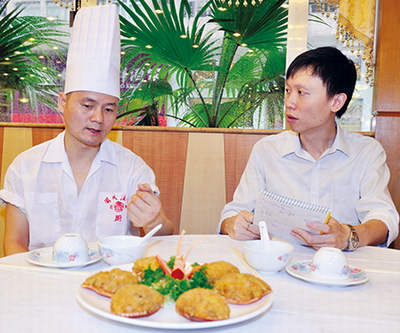
[Photo Caption: Chef TONG gives us some tips on cooking.]
Food Safety Plan Corner
Fried Breaded Crab Shells with Crab Meat – Cook Food Thoroughly
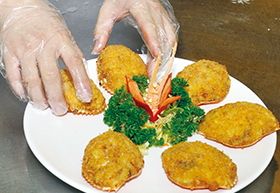
[Photo Caption: An attractive and tasty dish must also be safe for consumption.]
| Ingredients: | (Points to note) |
|---|---|
| Mud crabs (male) | Buy live crabs. |
| Pork | Not too fatty. |
| Olive seeds | Available at groceries selling produce from Shunde District of China. Slightly deep fry the seeds for later use. |
| Chinese mushrooms | Soak in water, remove stems and rinse again. |
| Onions | Peel and remove hard layers. |
| Winter bamboo shoots | Peel and remove hard layers. |
| Egg yolk, egg white | |
| Breadcrumbs |
Seasoning:
A suitable amount of salt, sugar and cornflour together with a little pepper, Shaoxing wine and sesame oil.
Steps:
- Separate crab shells from crabs and cut the crab bodies into pieces. Remove internal organs and legs of crabs. Rinse the ingredients thoroughly.
- Cook crab shells and crab bodies in boiling water for 8 minutes. Then extract meat from crabs for later use.
- Soak Chinese mushrooms in water, peel and dice onions and winter bamboo shoots. Deep fry olive seeds until fragrant.
- Chop up pork and shrimp meat.
- Add a small amount of egg white and seasoning to the prepared crab meat, pork, shrimp meat, olive seeds, Chinese mushrooms, onions and winter bamboo shoots. Mix well. Set aside for use as filling.
- Brush the inside of crab shells with a layer of egg white. Stuff a suitable amount of filling into the crab shells. Lightly press the filling with hands. Glaze filling with beaten egg yolk and coat with breadcrumbs.
- Deep fry the stuffed crab shells in boiling oil for about 4 minutes until the surface turns golden brown.
Production Process
It is a step or procedure in a food manufacture process at which control can be applied and as a result, food safety hazard can be prevented or eliminated.
There is one Critical Control Point in the production of Fried Breaded Crab Shells with Crab Meat:
- Food should be cooked thoroughly before consumption.
Briefing of Activities
Roving Exhibitions on Food Safety
In order to publicise food safety messages and arouse the awareness of the public and the food trade on food safety, the CFS regularly organises thematic exhibitions in public housing estates and major shopping centres. There are exhibition panels covering different topics such as nutrition labelling, 5 Keys to Food Safety, the Food Safety Charter and genetically modified food. Educational videos are shown, and there are also games in the exhibitions which give out souvenirs to participants.
For details of the roving exhibitions, please visit the CFS website (www.cfs.gov.hk).

"Safe Food • Gourmet Paradise" Photo Competition
The theme of the competition is to display the unlimited variety of high quality and delicious foods available in Hong Kong and highlight the importance of food safety and Hong Kong's international reputation as a "Gourmet Paradise".
The competition is divided into the Secondary School Section and Public Section.
Entrants must be Hong Kong residents.
The standard format for photo entries is as follows:
- The digital photo may be either colour or black-and-white. It should be submitted in JPEG format with a resolution of at least 5 mega pixels with a file size between 2MB and 5MB.
- Images must be free of manipulation other than ordinary changes such as exposure correction and adjustments to white balance, contrast and saturation.
- All entries must be the original works of the entrants. The works must not have been previously published or have won any awards in any other competitions.
Judging Criteria:
Relevance (40%), creativity (20%), artistic composition (20%), photographic technique and colour rendering (20%)
Awards:
There will be one Champion, one first runner-up, one second runner-up and three merit awards for each section.
The winners will be awarded a trophy and book / cash vouchers of HK$5,000, HK$3,000, HK$2,000 and HK$1,000 respectively.
Entry method:
Entries, together with the completed entry forms, should be submitted to the Communication Resource Unit, Risk Communication Section, Centre for Food Safety (Address: 8/F, Fa Yuen Street Municipal Services Building, 123A Fa Yuen Street, Mongkok, Kowloon).
Deadline:
15 February 2013
Results of the competition will be announced on the CFS website in May 2013.
For details of the competition, please visit the CFS website at www.cfs.gov.hk or contact the Communication Resource Unit on 2381 6096.
Truth against Fallacy
Q: Can we ensure safe food handling by using gloves?
A: No. Wearing gloves is only a way to minimise manual contact with ready-to-eat food. If gloves are used improperly, it may increase the risk of cross-contamination as gloves can become contaminated with bacteria in the same way as hands. Gloves are only beneficial when a new pair is used for each activity and we take care of our hygiene when changing gloves.
Then, how can we use gloves correctly? First of all, we should know when to use gloves and how to use them correctly.
When to use gloves?
When there is cut on hands or when we handle ready-to-eat food.
How to use gloves correctly?
* Use disposable gloves.
* Wear gloves of appropriate size.
* Wash hands thoroughly before wearing gloves, between glove change and after removal of gloves.
* Discard gloves after use and never reuse gloves.
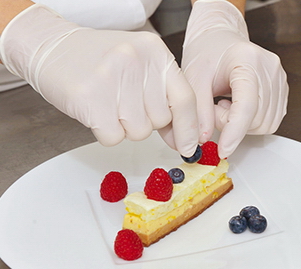
[Photo caption: Food handlers should still observe good personal hygiene when wearing gloves.]
All in all, washing hands thoroughly is actually the best way to prevent contamination of food by hands.
Key points to note:
- Wearing gloves can by no means substitute hand washing and good personal hygiene.
- Improper use of gloves is as unhygienic as inadequate hand washing.
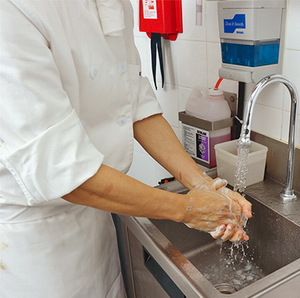
Brain Gym
- When was the Award Presentation Ceremony of the "Live it, Use it" Nutrition Labelling Promotion Award Scheme held this year?
- 26 May 2012
- 20 June 2012
- 9 July 2012
- 11 July 2012
- Where was the Award Presentation Ceremony of the "Live it, Use it" Nutrition Labelling Promotion Award Scheme held this year?
- Tsuen Wan Town Hall – Cultural Activities Hall
- Tuen Mun Town Plaza
- Wong Tai Sin Lung Cheung Mall
- Ngau Chi Wan Town Hall – Cultural Activities Hall
- The participants of the "Live it, Use it" Nutrition Labelling Promotion Award Scheme were divided into two groups. What were they?
- Basic Group and Advanced Group
- Junior Group and Senior Group
- Lower Form Group and Upper Form Group
- Elementary Group and Senior Group
Enquiry and Subscription
Printed copies of the Food Safety Express can be collected at the Communication Resource Unit located at 8/F, Fa Yuen Street Municipal Services Building, 123A Fa Yuen Street, Mong Kok, Kowloon. For enquiry, please call 2381 6096. The public may also visit the website of the Centre for Food Safety (http://www.cfs.gov.hk) for the online version.
